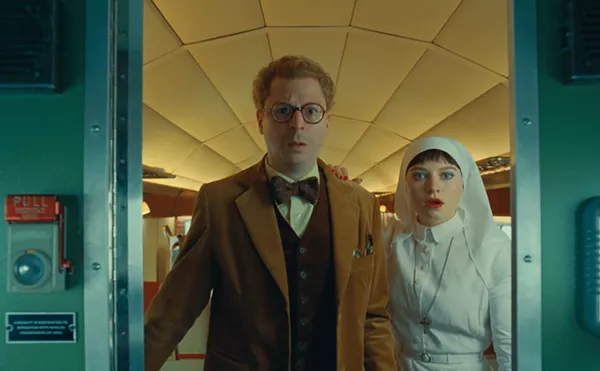"It's way more complex than just swamps and alligators," Tim Wride says, offering what he knows to be a grand understatement with a soft chuckle while describing the knotty subject of his latest undertaking at the Norton Museum of Art: "Imaging Eden: Photographers Discover the Everglades."
As curator of photography for the museum, Wride is right in this statement, not only in the intricate nature of the ecosystems that make up and rely on America's largest subtropical wilderness but in layers of complexities regarding people's relationships to the 2 million-acre wetland ecosystem reaching from Central Florida to Florida Bay.
It is at once a space of environmental wonderment and economic potential, counting the Florida panther, crocodiles, a thousand forms of plant life, alligators, 27 unique species of snakes, and more than 350 bird species as residents within its barriers.
It is the same location with a deeply painful past, one where, in 1845, within days of Florida's admission into the Union, congressional talks took place to discuss large-scale drainage of the Everglades and, soon after, military campaigns to wipe out the native, indigenous people and escaped slaves for whom the Everglades was home. It has been the site of development, boom and accompanying bust, and years of stalled restoration efforts.
It has been deemed a "World Heritage Site in Danger," a "Wetland of International Importance," and a specially protected area under the Cartagena Treaty of 2012. And yet in a parallel story line, it is also a place that is largely strange and unknown to many of South Florida's most recent occupants, whose main tangible interaction with it might be witnessing it in a greenish-brown blur while whizzing by on I-75, getting from one touristy, sandy coast of Florida to the next.
"I was always shocked by how little people knew about this place."
tweet this
Wride hopes to change that last little bit of the Everglades story with this show — a task he took on as a photo historian when he noticed that, unlike other national and international treasures, the Everglades had scant photographic evidence of its existence in the 19th Century, never systematically imaged until the 20th Century.
"As a photo historian, I began thinking — you look at the Colorado River, Grand Canyon, Yosemite, Egypt, India — all famously photographed within the 19th Century, and yet in the Everglades, there is none of that for our records," Wride explains. "It's more vernacular photography done by people who were actually going out into the Everglades to reclaim the land and drain the swamp."
While the pioneers of early landscape photography may have missed an opportunity in Florida, that has been made up for over and over again with efforts in the last century.
"Imaging Eden" contains more than 200 images, Audubon prints, roadside postcards, and antique maps that aim to look at imagery and how it helped to create both the myths and the realities of the Everglades. "I think the original myth is that it's just a swamp when in reality, very little of it is swamp," Wride says, "but the other myth is that it is just this one homogenous, complete entity when in reality it is this whole enterprise of many different ecosystems, each relying on the other."
So Wride went on a mission to put together a timeline of photographic evidence of the Everglades' past, but then also wanting to give a proper sendup to the Everglades' future, he commissioned five internationally recognized photographers to go into the Everglades for 18 months and document what they saw in an effort to advocate for this environment and provide context for conversations about Everglades restoration efforts. Wride selected Korean photographer Jungjin Lee; Netherlands-based Bert Teunissen; and Jim Goldberg, Gerald Slota, and Jordan Stein, all from the United States. The irony and problematic issue of having outsiders documenting this space is not entirely lost on Wride, as he is still getting his own footing here himself.
"I'm not a local; I am a recent transplant [from California], so for me, it was a recent discovery," he says, "but I was always shocked by how little people knew about this place... so do I want to proselytize? I guess I do... I really just want people to go experience the place they live in."
Momentary chest-thumping aside, Wride says the result was just to learn and show others — even those who have lived their entire lives in the Sunshine State — something new about the place they occupy.
"I wanted to commission artists to go into the Everglades to teach me. As a curator, I am really reliant on the artist to teach me things and show me things, which is why I wanted to send artists whose work I respected."
It's all there — from the lush, otherworldly work of Eliot Porter's Cypress Slough and Mist, Cypress Lodge, Punta Gorda, Florida, January 31, 1974 to Adam Nadel's bizarre Non-Native Seminole War Re-enactor to the late 1980s' James Balog images of the Florida panther. Starting out under dim lights with historic maps, the show snakes and weaves through time and development as overhead lighting gets brighter and brighter until we reach the commissioned works and modern documentation of the Everglades at the end in a brightly lit space.
"It follows that trajectory but also follows the trajectory of the way photos have functioned over time in the way that our relationship to nature as a culture has shifted over time," Wride says. "By the time you get through the contemporary work, it's much brighter because we shine a brighter light on it; it's also more cacophonous because there are so many efforts now."
"Imaging Eden: Photographers Discover the Everglades" runs now through July 12. Wride heads weekly talks on the exhibit, where he is consistently surprised at how much of this place remains a mystery to many of the show's attendees.
"And that's why I curated this project, because I had only seen pictures of the Everglades. When I was amongst all the fresh pine forest, I was like 'Well, where's the real Everglades?' Because all I had ever seen in pictures was all of the water and swamp and alligators."







